Buying your first home is exciting—but if you’re still locked into a rental agreement, breaking your lease early can feel daunting. The good news is that in Australia, you can end your lease when you buy a house, but the process (and costs) depend on your state’s laws, your landlord’s cooperation, and how quickly the property is re-let. This guide explains your rights, potential costs, and smart ways to exit your lease with minimal stress.
Let’s dive in…
What Does Breaking The Lease Mean?
A lease is a legally binding agreement. If a tenant breaks the lease before the end of the term (the fixed-term agreement) without sufficient reason, they are breaking the lease. This is also called breaking the rental agreement.
The bad news: breaking a lease may require you to pay compensation to the owner or property manager. This could continue until the end of the original lease or until the property is re-let, because of potential loss of rent.
The good news: there are a few ways around this.
Usually, a homebuyer finds the perfect property and is ready to move. But sometimes, they still have 2, 3, or 6 months left on their lease.
Under the lease agreement, if you leave with 2 months remaining, you technically owe the owner or property manager for those 2 months of rent, even if you’re no longer living there.
When Can a Lease Be Terminated Immediately?
It is possible to end a rental agreement immediately in the following cases:
- The landlord breaches the terms of the rental agreement, such as failing to carry out necessary repairs.
- The tenant breaches the agreement, such as illegally subletting.
- The landlord and tenant agree in writing to end the agreement.
- The sole tenant passes away.
- The property owner’s mortgage company gives notice.

Realistically, first-home buyers usually only have option 1 available if they want to break the lease without paying compensation. More on the costs and strategies is covered below.
People break leases all the time, so if you need to break your lease, don’t worry — it’s completely doable.
What Are The Steps For Breaking My Lease?
Step 1. Notify the Property Manager in Writing
In nearly all cases, if a landlord wants to end a tenancy, they must notify you in writing. The same rule applies when you want to break your lease.
- Complete a Form 13 Notice of Intention to Leave.
- Send it to your property manager as soon as possible.
- The earlier you give notice, the easier it is to minimise costs.
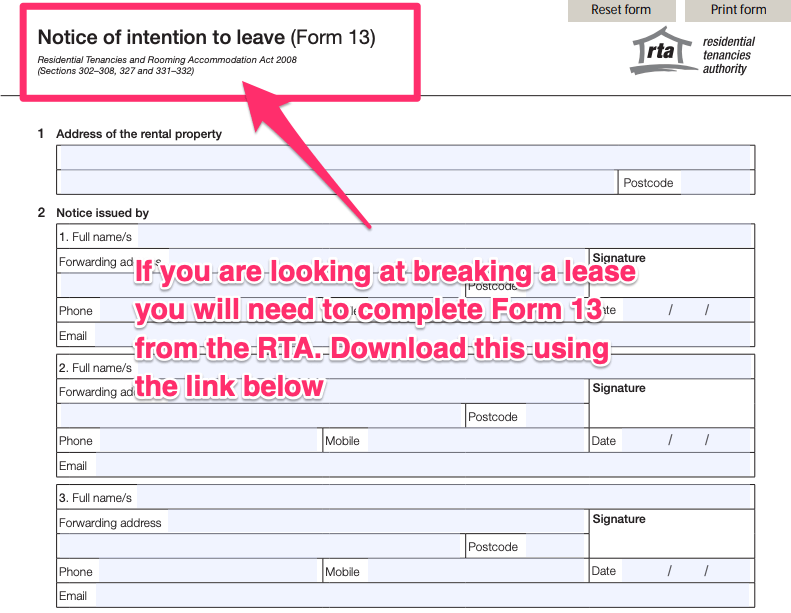
Step 2. Leave the Property on or Before the Proposed Date
Once you give notice, you cannot stay past the date on your form.
Before moving out, make sure to:
- Arrange a bond claim.
- Hire a professional cleaner and keep the receipt; landlords cannot charge extra.
- Organise pest control, if necessary.
- Tidy the garden if it’s overgrown.
- Take photos of the property to document its condition.
Leaving the property in good condition allows the landlord to re-let it quickly, saving you money.
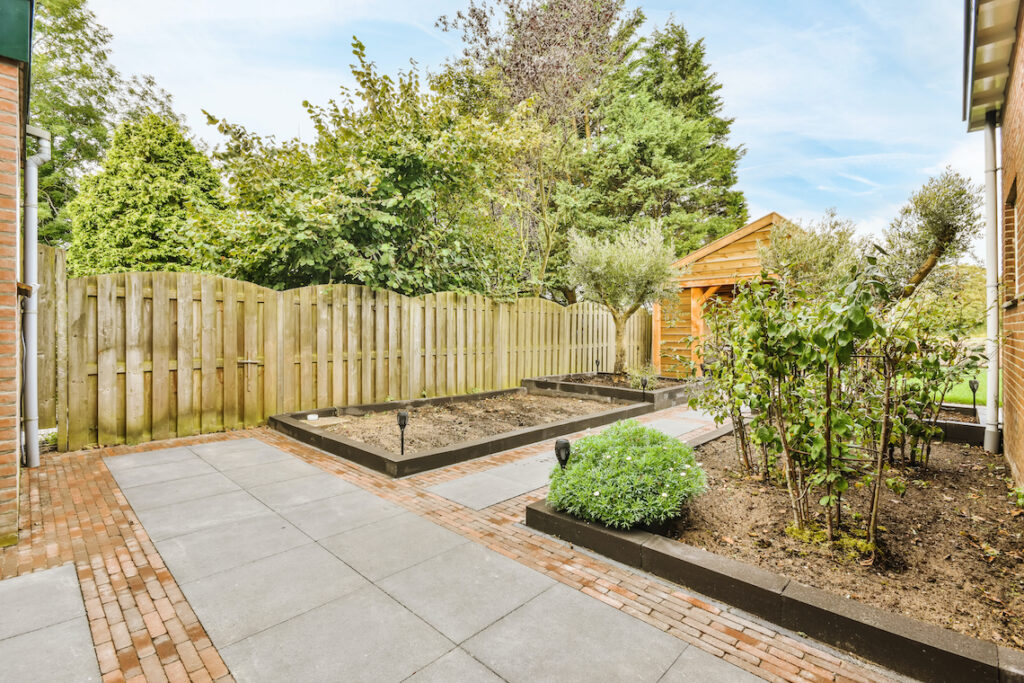
Step 3. Complete the Exit Condition Report
- Fill out Form 14a with your property manager or on your own.
- Submit the completed form to your property manager.
Step 4. Submit the Refund of Rental Bond Form
- Complete Form 4 (Refund of Rental Bond) after the exit condition report.
- Send it to your property manager to sign and lodge with the RTA.
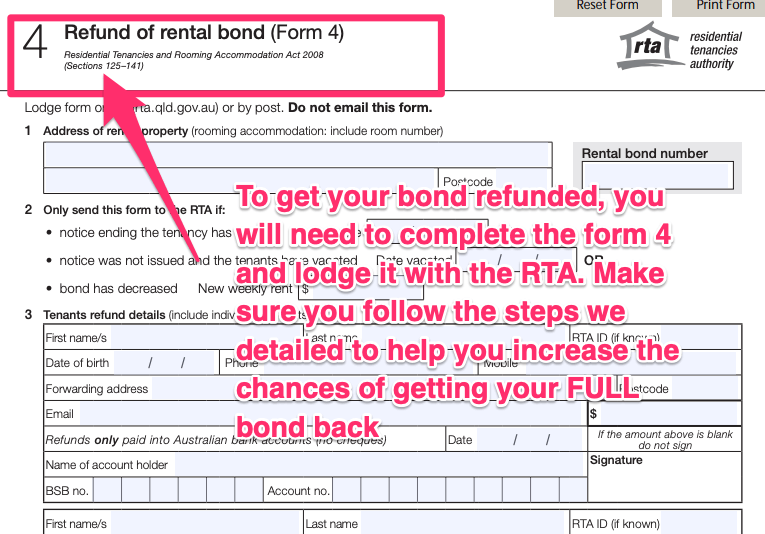
Tip: Download our break lease checklist to stay organised and ensure nothing is missed.
When Is My Tenancy Agreement Terminated?
Legally, your lease is not considered broken until you have returned vacant possession of the rental property. In simple terms, this means you must completely move out.

Excessive Hardship Applications in Queensland
If the property manager or landlord causes excessive hardship, you may apply to the Queensland Civil and Administrative Tribunal (QCAT).
- You must provide evidence to support your claim.
- QCAT can issue a termination order, which may:
- Exempt you from paying rent or compensation.
- Waive any fees from the date the order is issued.
Applying through QCAT is particularly useful if leaving the property early without agreement would create financial or personal strain.
What Costs Do I Need To Pay When Breaking My Lease?
According to the Residential Tenancies Authority (RTA), when breaking a lease, tenants may be required to pay certain costs. Landlords and property managers are legally obligated to minimise these costs, so keeping clear records is essential.
Common Costs When Breaking a Lease
Cost Type | What It Covers | Notes |
Re-letting costs | Usually 1 week’s rent plus GST | Charged to cover the effort of finding a replacement tenant |
Advertising costs | Actual cost of marketing the property | Only incurred if the landlord places ads or listings |
Compensation for lost rent | Rent owed until a new tenant moves in or lease ends | Applies only if the landlord cannot re-let immediately |
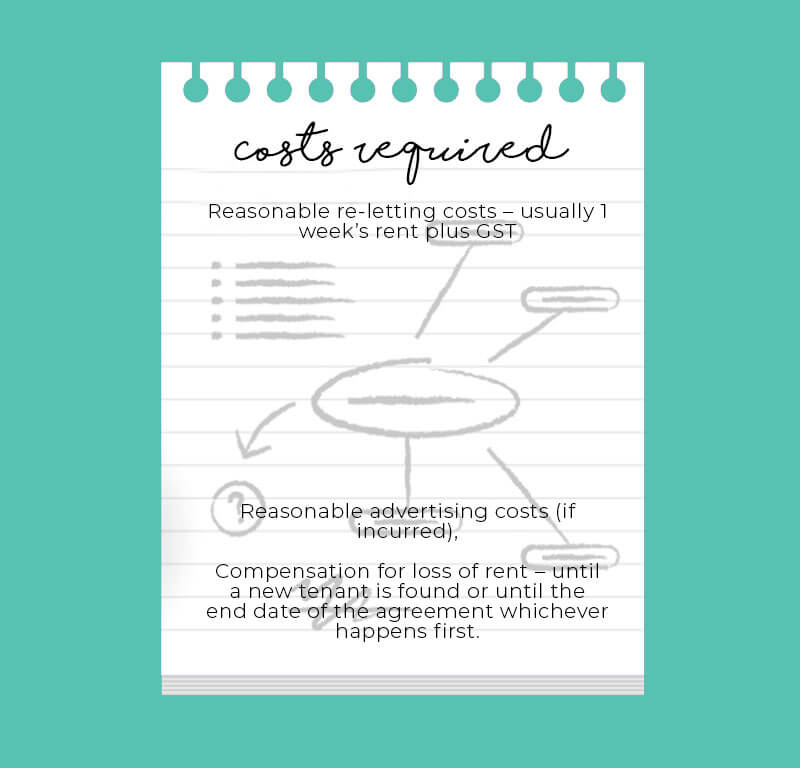
Example: What Costs Might Look Like
Imagine:
- You have 2 months left on your lease
- Rent is $500 per week
- It takes 4 weeks to find a new tenant
Cost Type | Amount |
Re-letting costs | $500 (1 week’s rent) |
Advertising costs | $100 |
Compensation for lost rent | $2,000 (4 x $500) |
Total | $2,600 |
This represents a worst-case scenario. If the landlord or property manager acts quickly, the costs may be much lower.
Tips to Minimise Your Costs
- Notify your landlord as soon as possible.
- Offer to help find a replacement tenant.
- Keep receipts for cleaning, repairs, and advertising.
- Request proof of re-letting efforts from the landlord.
- Consider applying to a tribunal (e.g., NCAT, VCAT, QCAT) if financial hardship applies.
By understanding these potential charges, you can plan your lease break more effectively and avoid unnecessary costs.
How Landlords Must Minimise Your Costs

According to Residential Tenancies Authority, when you break a lease, your landlord (or property manager) must take all reasonable steps to minimise their losses. This legal obligation is known as the “duty to mitigate loss.”
Here’s what that means — in plain English — and how you can use it to protect yourself.
1. They Must Advertise Promptly and at Market Rent
- The landlord must start advertising your property as soon as you give notice.
- They must advertise at a reasonable market rate, not higher, because charging too much can delay letting and increase your liability.
- As a tenant, you should ask: “When did the property go online? What rent was advertised?”
- If the landlord delays advertising or sets unrealistic rent, they haven’t mitigated their loss — you may challenge full liability.
2. They Must Accept Suitable Replacement Tenants
- If you find someone who wants to take over your lease, the landlord should consider them promptly.
- They must not reject a suitable applicant unreasonably, such as by charging extra rent or requiring unusual conditions.
- You can help here: offer to supply suitable tenant details, coordinate inspections, and provide references.
3. You Have the Right to Ask for Proof of Advertising or Re-letting Invoices
- The landlord must take real action and document it. If they don’t, you can use this to reduce what you owe.
- Ask for:
- A copy of the ad or listing date
- The rent they advertised for
- A copy of the agent’s invoice for advertising or re-letting (where permitted)
- If you discover they haven’t listed the property or delayed unreasonably, you may dispute part of the claim.
4. Keep Written Records of All Communication
- From your side: send your notice to vacate in writing, keep proof you delivered it.
- From their side: emails, letters, listing screenshots — these matter.
- Having this documentation strengthens your position and shows you acted responsibly.
5. Example: How Delay Could Reduce Your Liability
Imagine you give four weeks’ notice but the landlord only starts advertising three weeks later.
- That one-week delay could mean you don’t have to pay for that extra week.
- In Victoria, for instance, tenants only pay rent loss until a new tenant is found or the fixed term ends — but only if the landlord acted reasonably.
- In Western Australia, official guidance states the lessor must actively advertise and minimise rent loss — failure to do so affects the cost you owe.
Why This Matters for You as a Homebuyer
You’re breaking your lease because you’re buying a home. That’s a strong reason. But that doesn’t automatically erase costs.
• If the landlord fails to mitigate their loss, you pay less.
• If they do mitigate well, they may only ask for minimal lost rent until the new tenant moves in.
• The better you prepare and communicate, the better your outcome.
State-by-State Rules For Breaking A Lease In Australia

New South Wales (NSW): Fixed Break-Fee Structure
In NSW, the Residential Tenancies Act 2010 sets clear break-lease fees based on how far you are through your lease:
- 4 weeks’ rent – if less than 25% of the term has passed
- 3 weeks’ rent – if 25–50% has passed
- 2 weeks’ rent – if 50–75% has passed
- 1 week’s rent – if more than 75% has passed
If you’re breaking your lease due to hardship (job loss, illness, or family reasons), you can apply to the NSW Civil and Administrative Tribunal (NCAT) for a rent-reduction ruling.
Victoria (VIC): Pay Only “Reasonable” Costs
Victoria doesn’t have a fixed fee. Instead, tenants must cover reasonable costs only, such as:
- Advertising or re-letting fees (pro-rata to the remaining lease)
- Lost rent until a new tenant moves in
Your landlord must mitigate loss by re-letting quickly and at market rent.
If they delay, you can challenge the costs through VCAT.
Queensland (QLD): Apply for Hardship Through QCAT
In Queensland, you’re usually responsible for rent until the property is re-let, plus fair advertising and letting fees. If you’re under serious financial or personal strain, you can apply to QCAT to terminate early under hardship grounds.
Landlords must act reasonably — the RTA confirms they need to advertise promptly to reduce your costs.
South Australia (SA): 21-Day Notice and Fair Costs
Tenants on a periodic lease can leave with 21 days’ notice.
For fixed-term leases, you’ll pay reasonable re-letting and advertising costs until a new tenant moves in.
If continuing the lease causes hardship, apply to SACAT to end it early.
Western Australia (WA): Reasonable Re-Letting Costs
In WA, you can break a lease through mutual agreement or by applying to the Magistrates Court under hardship.
You’ll cover rent until a replacement tenant is found, plus reasonable re-letting and advertising costs.
Landlords must advertise the property promptly at market rent.
Tasmania (TAS): Hardship and Negotiation Options
Tenants can leave early by negotiating with the landlord or applying to the Residential Tenancy Commissioner (RTC) under hardship rules.
You’re responsible for rent until the home is re-let and must give 21 days’ written notice whenever possible.
Australian Capital Territory (ACT): End Early With Evidence
The ACT lets tenants end a fixed-term lease early if they pay rent until the property is re-let and cover reasonable advertising costs.
Hardship applications go through ACAT.
Landlords must document all re-letting efforts and act quickly.
Northern Territory (NT): 14-Day Notice and Tribunal Approval
In the NT, you can apply to the NT Civil and Administrative Tribunal (NTCAT) for early termination under hardship.
Tenants must provide at least 14 days’ notice and may need to pay rent and advertising costs until re-let.
Quick summary of the state by state rules for breaking a lease
State/Territory | Key Rules | Hardship or Tribunal Options |
New South Wales (NSW) | Fixed fees based on lease progress: 4 weeks’ rent (<25%), 3 weeks (25–50%), 2 weeks (50–75%), or 1 week (>75%). | Apply to NCAT for rent reduction if breaking due to hardship. |
Victoria (VIC) | No fixed fee — tenants pay only reasonable costs (e.g., pro-rata advertising or re-letting fees). | Can challenge excessive costs through VCAT if the landlord delays re-letting. |
Queensland (QLD) | Responsible for rent until re-let plus fair re-letting and advertising fees. | Can apply to QCAT to terminate early due to hardship. |
South Australia (SA) | 21 days’ notice for periodic leases; pay fair re-letting and advertising costs for fixed terms. | Apply to SACAT if continuing the lease causes hardship. |
Western Australia (WA) | Must cover rent and reasonable re-letting costs until a new tenant is found. | Can apply to the Magistrates Court under hardship provisions. |
Tasmania (TAS) | Can negotiate or apply for early termination under hardship; must give 21 days’ notice if possible. | Apply to the Residential Tenancy Commissioner (RTC) under hardship. |
Australian Capital Territory (ACT) | Can end lease early if rent is paid until re-let and advertising costs covered. | Apply to ACAT under hardship; landlords must prove re-letting efforts. |
Northern Territory (NT) | Must give at least 14 days’ notice; may owe rent and advertising costs until re-let. | Apply to NTCAT for early termination under hardship. |
What Are Some Ways You Can Break The Lease Without Costs?
Breaking a lease without paying extra is possible in certain situations. Here are the main strategies:
1. Check for a Breach of Contract
The landlord agrees to maintain the property and provide a safe environment.
- If they ignore repair requests for broken appliances, plumbing issues, mould, or pests, they may have breached the lease. This gives you a legal reason to end the lease without paying penalties.
- A breach can allow you to terminate the lease without paying costs. Keep written evidence of requests and responses to protect yourself in disputes.
2. Find a Replacement Tenant
Even if subletting isn’t allowed, you can find another tenant to take over your lease.
- If you know friends or colleagues looking to rent, this can be a quick solution. The new tenant must be approved by the landlord, but it can save you time and money.
- Buying a home usually takes at least 45 days from signing to moving in, giving you roughly 6 weeks to find a replacement. Use this period to advertise the property and line up prospective tenants.

3. Talk to Your Landlord or Property Manager
Negotiating a mutual termination can allow you to break the lease at no cost.
- The landlord might plan to move in, rent to a family member, or sell the property. Discussing your situation openly can uncover options you didn’t know existed.
- Asking never hurts — the worst they can do is say no. Even if they say no, early communication shows good faith and may reduce costs.
Tips to Minimise Costs Even if You Can’t Avoid Them
- Give early notice to give the property manager time to re-let the property. The sooner they can advertise, the less compensation you may need to pay.
- Help find a replacement tenant to reduce vacancy and lost rent compensation. Your efforts can shorten the time the property remains empty, saving money.
- Reduce advertising costs proportionally:
- If 50% of the lease remains, pay 50% of the advertising fee. This ensures you’re only responsible for your fair share of costs.
- If 25% of the lease remains, pay 25% of the fee. Always confirm the calculation with the property manager or landlord.
Download our break lease checklist to stay organised and minimise costs.
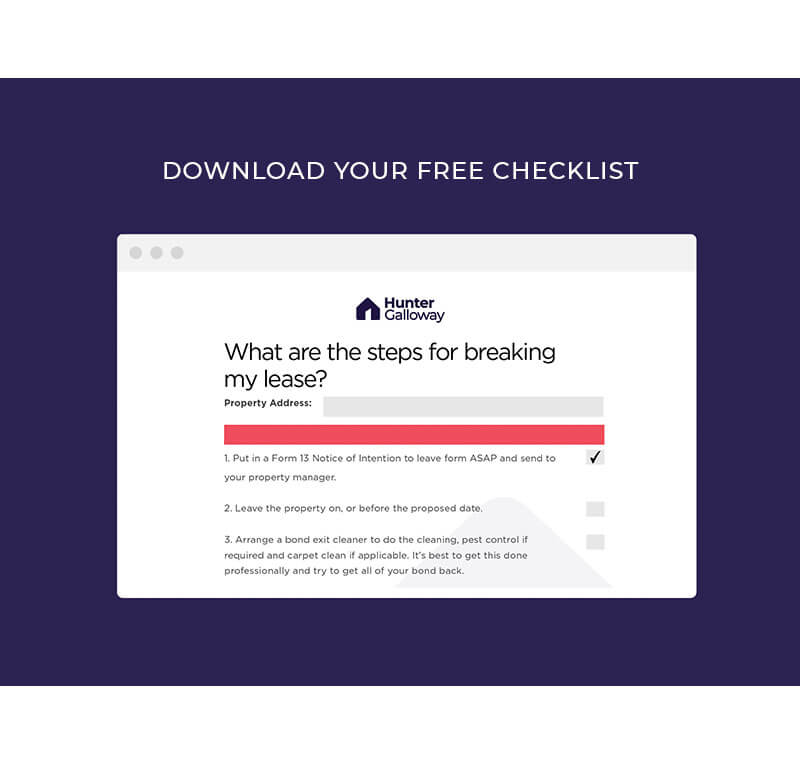
Case Study 1: How One Tenant Managed To Break A Lease Smoothly

Sophie, a renter in Brisbane, had a 12-month lease but landed a new job in another city. She only had 4 months left on her lease and wanted to move quickly without paying excessive costs.
Here’s what she did:
- Notified her landlord immediately in writing, explaining her situation.
- Helped find a replacement tenant from her network, reducing vacancy time.
- Paid reasonable advertising costs to list the property online.
Outcome:
- The property was re-let in just 3 weeks.
- Sophie only paid $650 in total, instead of the full remaining rent of $4,000.
- She kept all emails and receipts to avoid disputes.
Takeaway:
Communicating early and keeping records saved Sophie both money and stress. Helping the landlord re-let the property quickly significantly reduced her costs.
Case Study 2: The Cost of Breaking A Lease Without Notice

James in Sydney decided to break his 12-month lease without giving notice after deciding to buy a house. He left abruptly, thinking he could save time and hassle.
What went wrong:
- He lost his full rental bond because he did not follow procedure.
- The landlord charged him rent until a replacement tenant was found — 6 weeks of extra costs.
- He had no documentation to dispute the charges.
Lessons Learned:
- Always give written notice and follow your state’s lease-breaking rules.
- Helping find a replacement tenant can drastically reduce costs.
Keeping records of communication protects you from unnecessary charges.
Bonus: What Happens If You Buy A Property With Tenants?
Sometimes you may buy a property that already has tenants. In this case, you need to understand your rights and obligations.
1. Check if the Property Is Tenanted
- This information is usually in the contract of sale. Confirming tenancy status before purchase helps you plan for rental management.
- Ask the real estate agent when the lease ends. You are contractually bound to respect the lease unless the tenants agree to leave.
- Tenants may refuse to leave even if offered compensation, especially if they pay under-market rent. For example, tenants once rejected a $10,000 offer to leave early.
2. Do Extra Tenant Searches
- Speak with the managing agent to learn about tenant history. They handle maintenance and any tenant defaults.
- Request a copy of the rental ledger for the last 6–12 months. This shows if rent payments have been consistent and helps avoid surprises.
3. Get Landlord’s Insurance
- Landlord’s insurance protects against damage or missed rent while tenants occupy the property. This is important if tenants leave property damaged or fail to pay.

4. Leave a Licensed Property Manager in Place
- Avoid self-managing for short-term periods (2–3 months). The property manager handles repairs, rent defaults, and tenant issues efficiently.
- This reduces the risk of disputes with tenants or the RTA. Professional management ensures your investment remains secure during the transition.
Bonus: Should You Avoid Rent To Buy?
Rent-to-buy is essentially a lease agreement that allows a tenant to purchase a property at the end of the lease at a previously agreed purchase price. It eliminates the need to save a deposit, letting you use rental payments toward the deposit. However, it has several drawbacks.
- Exorbitant Rent – Rent in these schemes is often double the market rate. Paying more doesn’t always bring you closer to ownership.
- Overvalued Purchase Price –The purchase price is frequently inflated, sometimes by more than $100,000. Entering this scheme can put you in negative equity, relying on property values rising to benefit.
- No Legal Ownership – The property is not transferred into your name until the end of the lease. If the company running the scheme fails, you risk losing everything you’ve paid.
- Limited Financial Freedom –Rent-to-buy schemes handle tasks you could do yourself, such as saving for a deposit. Instead of paying overpriced rent, you could save and secure a regular mortgage, building equity faster.
- Proceed With Caution. If you’re considering a rent-to-buy scheme, go in with your eyes open. Get everything in writing, including fees and charges. Don’t leave any details unverified.

FAQs About Breaking A Lease To Buy A House
Will breaking my lease affect my credit score or future renting?
Breaking a lease does not directly impact your credit score. However, unpaid rent or property damage can appear in tenancy databases. Always settle costs and communicate with your property manager to protect your rental history.
Can I transfer my lease to someone else if I buy a house?
Yes. Most states allow a lease transfer or assignment. The new tenant must be approved by the landlord, which can help you avoid re-letting costs and reduce rent loss.
How can I reduce the cost of breaking my lease?
Give early notice, help find a replacement tenant, and leave the property in excellent condition. You can also negotiate a mutual termination with your landlord to lower costs.
Do I still have to pay rent if a new tenant is found quickly?
No. If a replacement tenant takes over immediately, your liability typically ends. Landlords must act reasonably and advertise promptly to reduce your costs.
What happens if I buy a house with months left on my lease?
You remain responsible for rent and reasonable costs until the lease ends or a replacement tenant is approved. Consider negotiating early termination with your property manager.
Can you negotiate buying out a lease?
Yes. You can offer a lump sum payment to your landlord to end the lease early. This can save both parties time and reduce ongoing costs.
What happens if the landlord breaks the lease?
If the landlord breaches the lease (e.g., fails to maintain the property), you may apply for early termination or compensation through your state’s tenancy tribunal. Keep records of all issues.
How do I terminate a lease early without penalty in Queensland?
In QLD, you can apply to QCAT under hardship grounds for early termination. Ensure the landlord is acting reasonably and advertise the property promptly. Helping find a replacement tenant can reduce costs further.
Next Steps From Here To Buy Your First Home
Our team at Hunter Galloway is here to help you make your home journey easy.
Unlike other mortgage brokers who are just one-person operations, we have an entire team of experts to help make your home loan journey as simple as possible.
If you want to get started, please give us a call on 1300 088 065 or book a free assessment online to see how we can help.








 Start again
Start again









